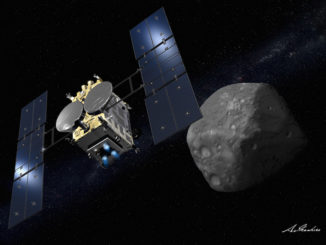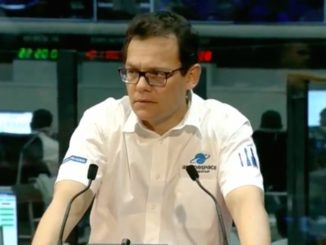Two pilots aboard Virgin Galactic’s commercial SpaceShipTwo suborbital rocketplane safely landed back in New Mexico Saturday after a “computer communications loss” triggered an abort of the craft’s engine ignition sequence.
Virgin Galactic, the space tourism company founder by billionaire Richard Branson, was attempting its first suborbital spaceflight from the company’s new home base at Spaceport America in New Mexico.
A jet-powered carrier aircraft took off from the New Mexico spaceport around 8:24 a.m. MST (10:24 a.m. EST; 1524 GMT) Saturday and flew to an altitude of around 50,000 feet (15,200 meters).
Pilots Dave Mackay and Rick “CJ” Sturckow climbed into the cockpit of the SpaceShipTwo rocketplane — named VSS Unity — before takeoff under Virgin Galactic’s carrier jet. Mackay is Virgin Galactic’s chief pilot, and Sturckow is a former NASA space shuttle commander.
After dropping from the carrier aircraft, the rocketplane was supposed to ignite its hybrid motor and pitch up to fly to an altitude of more than 50 miles, or 80 kilometers, the boundary of space recognized by the U.S. Air Force, NASA, and the Federal Aviation Administration.
But a technical problem caused the vehicle to abort its engine ignition sequence, cutting short the planned ascent into space. Mackay and Sturckow guided the Unity spaceplane back to a landing on the 12,000-foot-long (nearly 3,700-meter) runway at Spaceport America at 9:27 a.m. MST (11:27 a.m. EST; 1627 GMT).
“Our flight today did not reach space as we had been planning,” said Michael Colglazier, Virgin Galactic’s CEO, in a statement.
“After being released from its mothership, SpaceShipTwo Unity’s onboard computer that monitors the rocket motor lost connection. As designed, this triggered a fail-safe scenario that intentionally halted ignition of the rocket motor,” Colglazier said.
“Following this occurrence, our pilots flew back to Spaceport America and landed gracefully as usual,” Colglazier said.
“When I became CEO, I was briefed on the safety engineering of our spaceflight system, which is purposely designed to enable our pilots to safely glide back at any point,” he said. “Seeing firsthand how our pilots brought Unity in for a picture-perfect landing after an off-nominal condition confirmed this approach. I am even more confident that this is the level of safety that consumers will want and will be expecting from us.”
Thread: our CEO, Michael Colglazier, on today’s flight test. Today’s flight landed beautifully, with pilots, planes, and spaceship safe, secure, and in excellent shape — the foundation of every successful mission! Our flight today did not reach space as we had been planning. pic.twitter.com/pqfUAtp6UH
— Virgin Galactic (@virgingalactic) December 12, 2020
The rocket-powered SpaceShipTwo spaceplane is in the final phase of a multi-year test flight campaign before beginning commercial service carrying wealthy space tourists to the edge of space. Previous rocket-powered SpaceShipTwo flights originated from Mojave Air & Space Port in California, where Virgin Galactic builds its spaceships.
Virgin Galactic announced last year it was relocating its remaining test operations to New Mexico, where pilots performed two unpowered glide flight tests earlier this year. Virgin Galactic’s last successful rocket-powered test flight to the edge of space occurred in February 2019 over California’s Mojave Desert.
Before the abort Saturday, Virgin Galactic said the test flight would be the first of three rocket-powered missions from Spaceport America before it begins commercial operations. The next flight, scheduled for early 2021, was to carry four company employees, or “mission specialists,” to test and refine equipment, procedures, and training for future commercial passengers.
That would precede a final test flight to space with Branson on-board, Virgin Galactic officials said.
Virgin Galactic said before Sunday’s test flight that the mission would provide some of the data the company needs to close out its final two verification reports to the FAA, which licenses commercial spaceflight operations in the United States.
The aborted test flight Saturday could affect those plans.
“As we do with every test flight, we are evaluating all the data, including the root cause assessment of the computer communication loss,” Colglazier said. “We look forward to sharing information on our next flight window in the near future.”
While there were no passengers on-board the SpaceShipTwo vehicle Saturday, two NASA-sponsored microgravity research experiments were installed inside the spaceplane’s cabin.
Email the author.
Follow Stephen Clark on Twitter: @StephenClark1.



